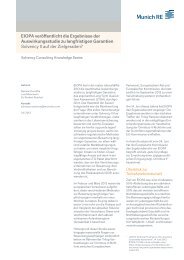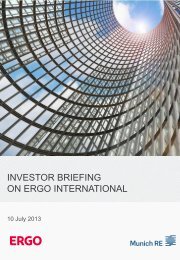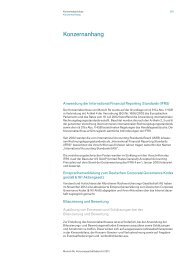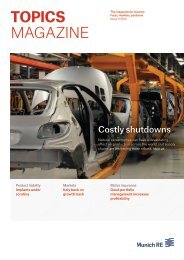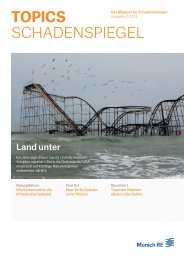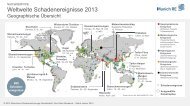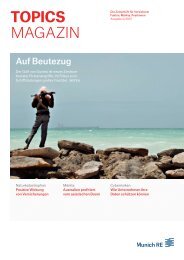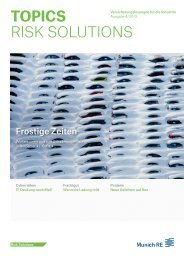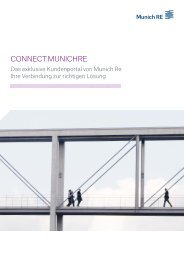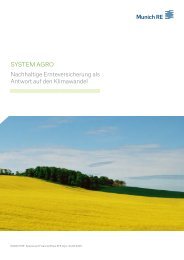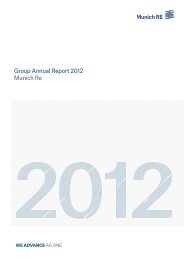Munich Re Group Annual Report 2006 (PDF, 1.8
Munich Re Group Annual Report 2006 (PDF, 1.8
Munich Re Group Annual Report 2006 (PDF, 1.8
You also want an ePaper? Increase the reach of your titles
YUMPU automatically turns print PDFs into web optimized ePapers that Google loves.
<strong>Munich</strong> <strong>Re</strong> <strong>Group</strong> <strong>Annual</strong> <strong>Re</strong>port <strong>2006</strong><br />
<strong>Re</strong>muneration report<br />
Structure of the remuneration system for the Board of<br />
Management<br />
In compliance with the German Corporate Governance<br />
Code, we here explain the principles of the remuneration<br />
system for <strong>Munich</strong> <strong>Re</strong>’s Board of Management and the<br />
structuring of the individual remuneration components.<br />
Structure and system of the Board of Management’s remuneration effective 1 January <strong>2006</strong><br />
Fixed components<br />
Basic remuneration<br />
The fixed annual basic remuneration is paid in the form of<br />
a monthly salary.<br />
<strong>Re</strong>muneration in kind/fringe benefits<br />
<strong>Re</strong>muneration in kind and fringe benefits are granted<br />
according to function, and are in line with market trends.<br />
Tax on the related benefits is subject to the individual tax<br />
rates of the respective Board member; the tax burden is<br />
borne by the Company.<br />
Variable components<br />
Short-term compensation component – <strong>Annual</strong> bonus<br />
This compensation component is based on different cat-<br />
114<br />
Management report_Corporate governance report<br />
The structure and amount of the remuneration are determined<br />
by the Supervisory Board’s Personnel Committee,<br />
whose three members comprise the Chairman of the<br />
Supervisory Board, another of the shareholder representatives<br />
and one of the employee representatives. The full<br />
Supervisory Board discusses the remuneration structure<br />
and reviews it regularly.<br />
Component Assessment basis/ Corridor Precondition for Payment<br />
parameters payment<br />
Basic remuneration, remuneration Function, responsibility, Fixed Contractual stipulations Monthly<br />
in kind/fringe benefits (company<br />
car, healthcare, security measures,<br />
insurances)<br />
length of service on Board<br />
Short-term compensation Consolidated result 0–150% Achievement of objectives <strong>Annual</strong>ly, in the<br />
component Company result 0–150% following year<br />
<strong>Annual</strong> bonus Divisional result 0–150%<br />
Individual objectives 0–150%<br />
Medium- and long-term Consolidated result 50–150% Achievement of objectives at In the fourth year<br />
compensation component least 50% on average over three<br />
Medium-term bonus years<br />
Share-price-based Appreciation in share price 0–150% > End of vesting period As from third year of<br />
compensation component (two years) plan until end of plan<br />
Long-term incentive plan > 20% share price increase<br />
(stock appreciation rights; > MR shares have outperformed<br />
term: seven years) EURO STOXX 50 twice at the<br />
end of three-month period<br />
during the term of the plan<br />
<strong>Re</strong>tirement plan Basic remuneration Fixed > <strong>Re</strong>tirement –<br />
Pension entitlement Number of years on the Board > Insured event<br />
> Premature termination or<br />
non-extension of employment<br />
contract under certain circumstances<br />
egories of objectives. The targets and scaling for <strong>Group</strong>,<br />
corporate and divisional objectives are geared to particular<br />
indicators; individual objectives form the basis for the<br />
achievement of personal targets. The key indicator used<br />
for the <strong>Group</strong> objective is return on risk-adjusted capital –<br />
RORAC, which is comprised of key figures from external<br />
accounting, and from other key portfolio and performance<br />
data. Information on the definition of RORAC is provided<br />
on page 54 f. We use the performance measures embodied<br />
in value-based management for the corporate and divisional<br />
objectives.<br />
The processes defined to specify objectives and assess<br />
their achievement also involve the external auditor, who<br />
examines targets and their fulfilment for correctness,<br />
objectivity and reliability. The audit results and any poten-



